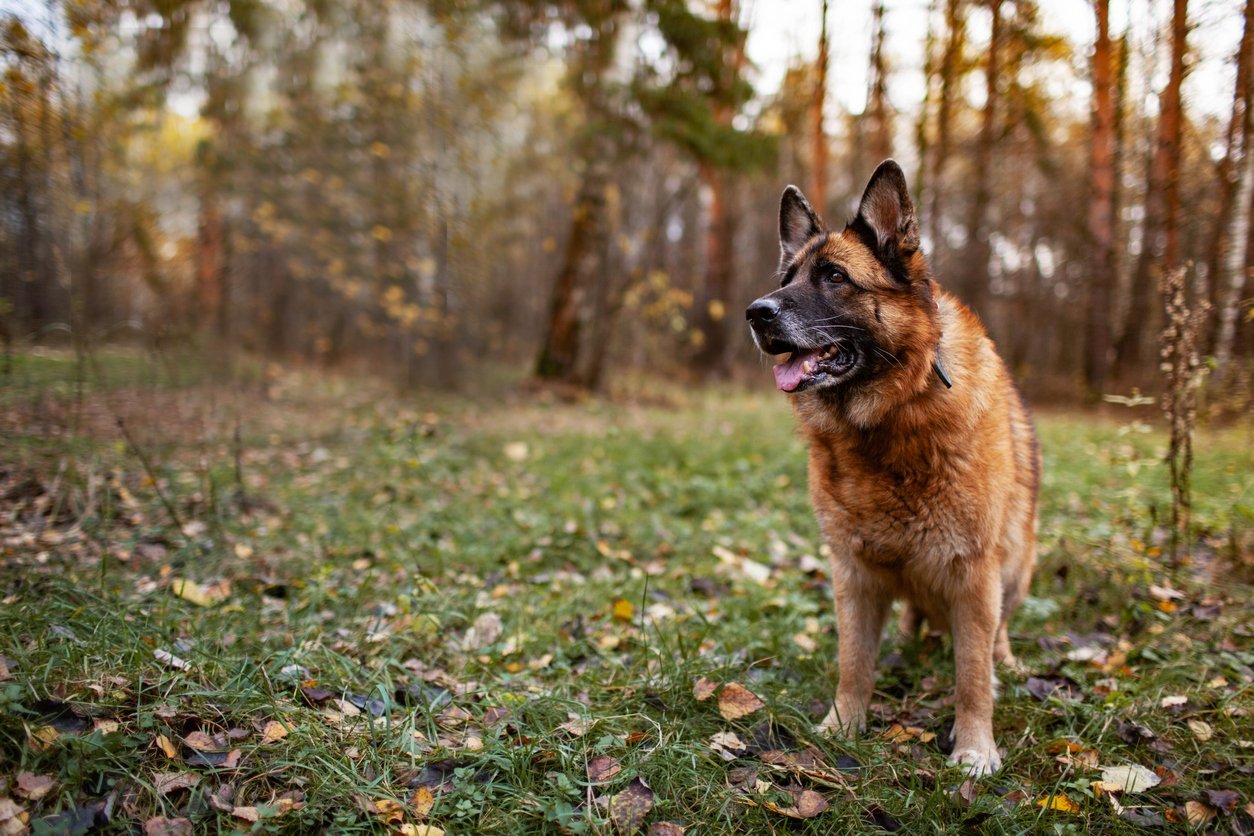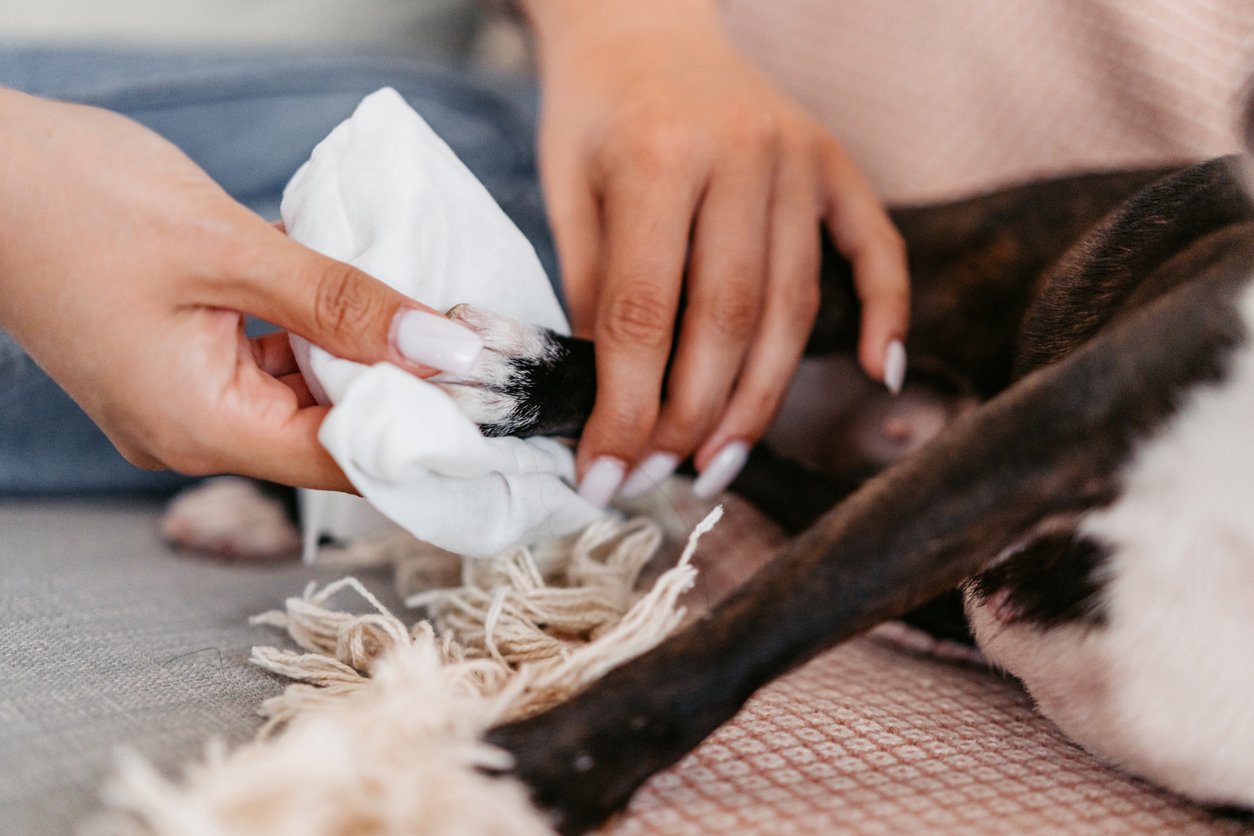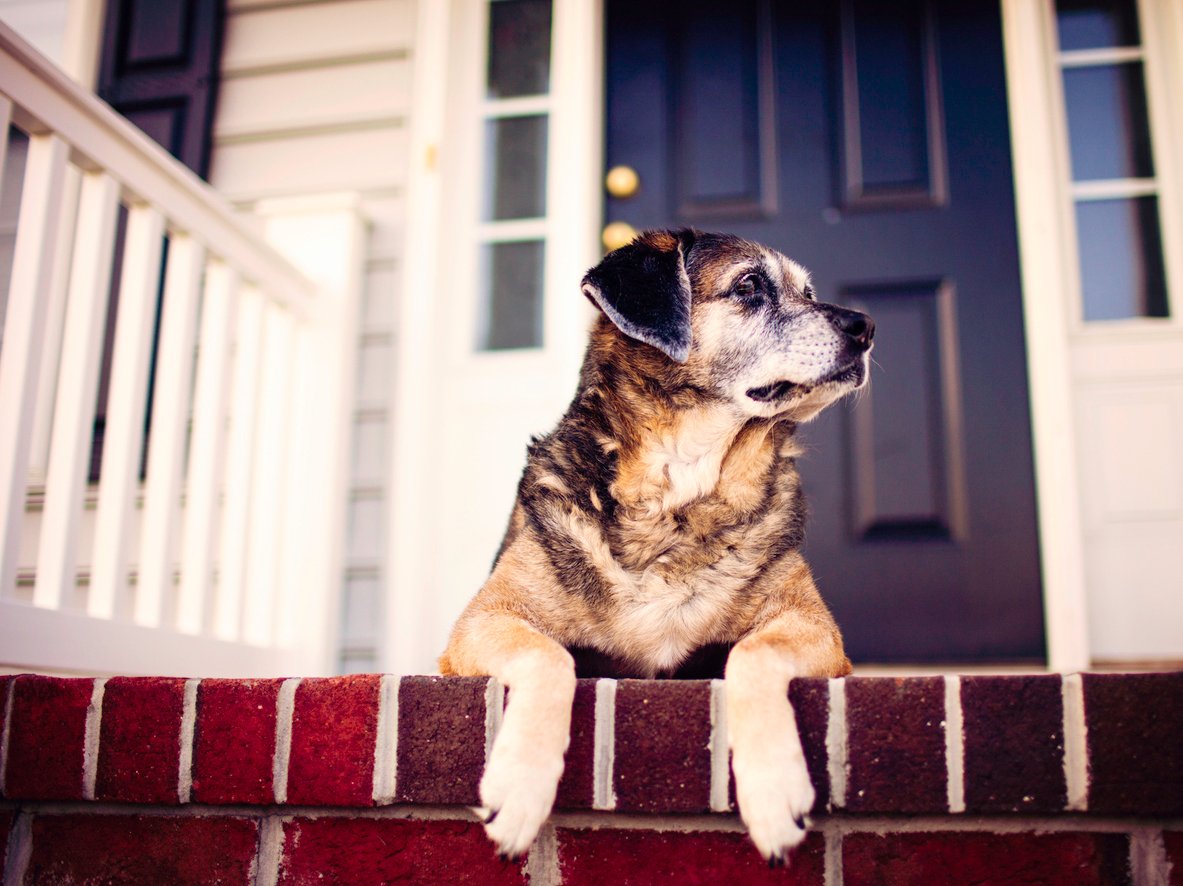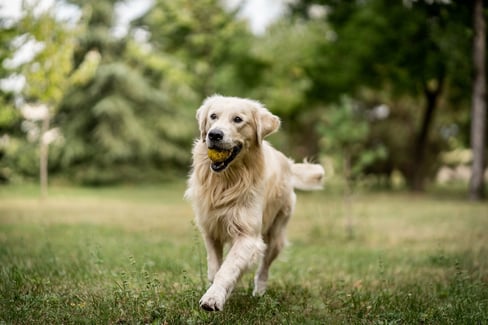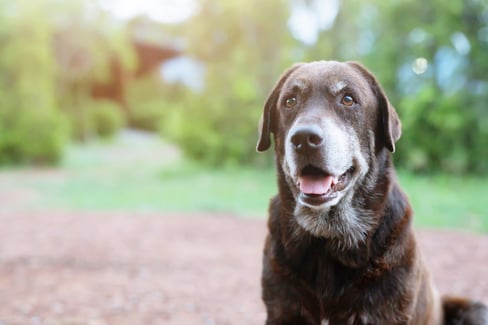Table of Contents
Your German Shepherd used to love going on walks.
But lately, he hasn’t been perking up quite the way he used to when you grab his leash. Rather than rushing to you while wagging his tail, he’s taking a bit longer to sit up.
And sometimes he even limps.
You know something’s off and are wondering if it might be hip dysplasia.
While German Shepherd hip dysplasia can have a significant impact on your pup’s life (and let’s be real — yours, too!), you don’t need to fret quite yet.
The “leash” we can do is provide you with some expert information.
Ready to dig in? Keep reading to learn all about how to prevent and treat hip dysplasia, so you and your dog can get back to enjoying your evening walks together again in no time.
Quick Intro to German Shepherd Hip Dysplasia
So, you may be wondering: what the heck causes hip dysplasia anyway?
As the name suggests, this condition occurs in your dog’s hip, specifically the ball-and-socket joint. In some puppies, the ball part of the ball-and-socket joint (which is the end of your dog’s femur bone) doesn’t form properly.
Because the ball doesn’t fit properly inside the socket, it causes looseness in the joint. This can lead to all of those unpleasant symptoms that are characteristic of hip dysplasia, from minor inflammation to full-blown arthritis.
And this is by no means an uncommon condition. Unfortunately, approximately 20.6% of German Shepherds have hip dysplasia, largely due to the role genetics play in the transmission of this condition. We’ll talk more about this soon!
So if you suspect German Shepherd hip dysplasia, a vet can confirm a diagnosis by taking an x-ray of your dog’s hips.
Why are German Shepherds Prone to Hip Dysplasia?

We just mentioned that there’s a high proportion of German Shepherds that have hip dysplasia, which is sort of strange. Let’s find out exactly why that is.
1. Genetics
In addition to all the great things about German Shepherds, from being highly intelligent to diligent workers, genes play a role in all those not-so-great traits too.
Yup, that’s right. Your dog’s proclivity to dig all those huge holes in your backyard may be genetic.
And, unfortunately, so are German Shepherd hip problems. Scientists think that many different genes contribute to the development of hip dysplasia. In fact, genetics may account for up to 25% of a dog’s chance of developing this condition.
These genes get passed down from generation to generation. And in full-bred dogs, like German Shepherds, these traits end up getting concentrated in the breed, perpetuating the cycle.
So when a parent has certain genes that make them inclined towards hip dysplasia, they may pass those on to their pups.
2. Size
Larger dogs are more likely to develop hip dysplasia than smaller ones. That’s because large dogs consume more calories and grow at a much faster rate than smaller dogs.
And unfortunately, if your dog’s hips grow too quickly, he may be more likely to develop hip dysplasia.
Additionally, the extra pounds on a large dog place more pressure and strain on his hips. When you consider the role genetics play in the development of German Shepherd hip dysplasia, and then add in the fact that German Shepherds are large dogs, it begins to make more and more sense that they’d be susceptible to developing this condition.
3. Exercise
Pet parents are likely to think their German Shepherd pup needs a ton of exercise since it’s a big dog breed.
Which is true.
But the way you provide that exercise is also important. You don’t want to push your puppy too hard too soon.
That’s because intense exercise at a young age can cause your dog to be more likely to develop hip dysplasia.
Additionally, too much exercise can cause injuries, and hip injuries may lead to German Shepherd hip dysplasia.
It’s a vicious cycle.
So what do you do? Rather than take your dog on an hour-long walk every day, go on several shorter walks a day.
And as fun as it is, you should avoid playing too much fetch until your puppy’s hips have had the chance to fully develop.
German Shepherd Hip Dysplasia Signs & Symptoms
You’re likely already familiar with a couple of German Shepherd dip dysplasia signs if you’re here:
- Bunny hopping gait
- Decreased activity
- Limping or lameness
- Stiffness
- Slow to rise from sitting position
- Signs of pain
After all, you may have noticed some of these symptoms in your own dog, leading you down the web rabbit hole of self-diagnosing your pup. We’ve all been there.
But stop doing that! You’re not helping anyone, least of all you or your dog.
If you notice any of these symptoms, go ahead and pick up the phone to make a vet appointment instead of continuing your never-ending, anxiety-fueled research.
Your vet can then perform a thorough examination and order an x-ray to look for signs of this condition.
And you can rest easy knowing you have an actual diagnosis, instead of lots of hypotheticals. You can thank us later.
Preventative Measures for Hip Dysplasia in Dogs
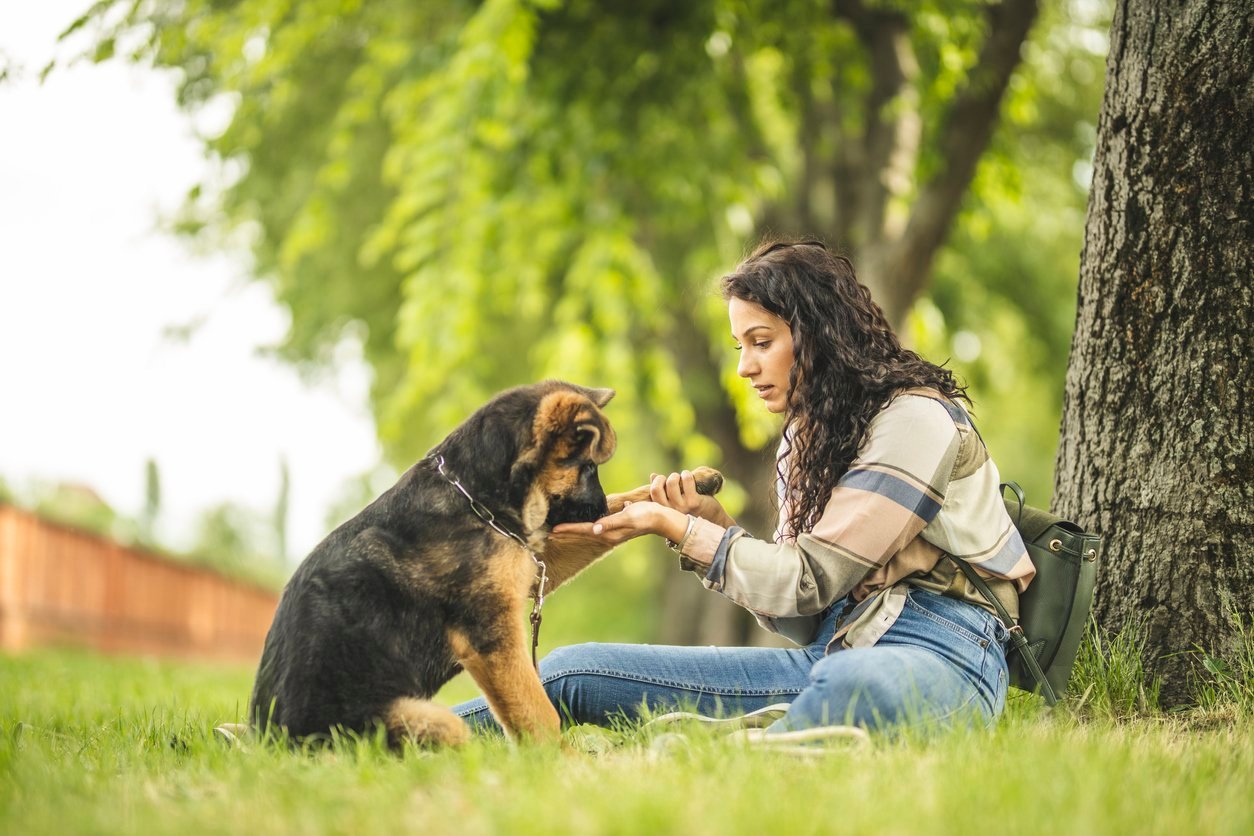
Since German Shepherd hip dysplasia is often a genetic condition, it’s not entirely preventable; however, there are certain actions you can take to reduce the likelihood that your dog will develop this health condition.
1. Choose a Certified Breeder
One of the best things you can do to reduce the likelihood of adopting a German Shepherd that has hip dysplasia is choosing a certified breeder.
A certified breeder should have a detailed history of the dog’s parents, so you can find out if there’s any history of hip dysplasia.
More specifically, try to find a breeder that uses hip screening procedures, such as the screening that OFA and PennHip perform.
This basically just means that your breeder has submitted x-rays of the dogs it breeds to one of those organizations. OFA or PennHip then alerts breeders to any signs of hip dysplasia, and the dogs are (ideally) taken out of the breeding pool.
And the result?
Your new puppy is that much less likely to carry any genes that will make him prone to developing German Shepherd hip dysplasia. Pretty snazzy!
2. Control Food Portion Size
Is your German Shepherd constantly giving you puppy dog eyes for more food?
Resist the cuteness and save his hips!
A study identified that German Shepherd puppies who were allowed to eat as much as they wanted to had a higher incidence of developing hip dysplasia. Puppies who were subject to portion control, on the other hand, were less likely to develop this condition.
As such, controlling food portion size may reduce the likelihood that your dog’s hips will grow too fast as a puppy.
Additionally, portion control helps keep your dog at a healthy weight. This is significant because extra pounds can exacerbate the symptoms of hip dysplasia.
If you aren’t sure what the right portion size is for your pup, share a conversation with your vet. She can help you determine how much to feed your German Shepherd at each stage of life.
3. Opt for Frequent but Gentle Exercise
While playing fast and furious with your pup may be loads of fun, it’s not so great for his hips.
Exercising your pup too hard at a young age can make him more likely to develop hip dysplasia as he grows. It may also lead to more injuries, which is also associated with a higher incidence of hip dysplasia in dogs.
Rather than playing endless games of fetch with your German Shepherd puppy, try doing one of the following forms of exercise instead:
- Go for a short walk around your neighbourhood multiple times a day.
- Swim at the lake.
- Practice leash training so that when your puppy gets big, he can enjoy all his walks without pulling your arm out of its socket.
4. Add a Joint Supplement
Hip dysplasia often occurs when the joints don’t set properly during growth. Adding a joint supplement during growth and maturation can reduce the chances of developing dysplasia. TRI-ACTA Regular Strength is a great option for young and growing dogs to support proper development, maintenance, and dietary completeness. Half the recommended serving by weight of TRI-ACTA Regular Strength is all a puppy or young dog would require.
TRI-ACTA for Pets
A proactive approach for developing and younger adult pets to maintain optimal joint health mobility, minimize inflammation and fend off age-related ailments.
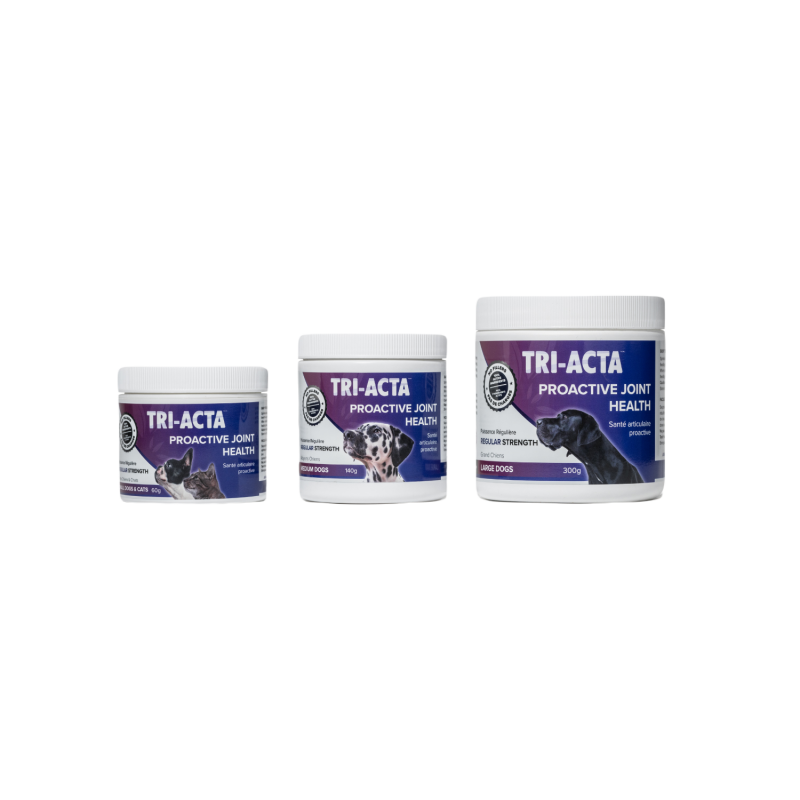
Treatments for German Shepherd Hip Dysplasia
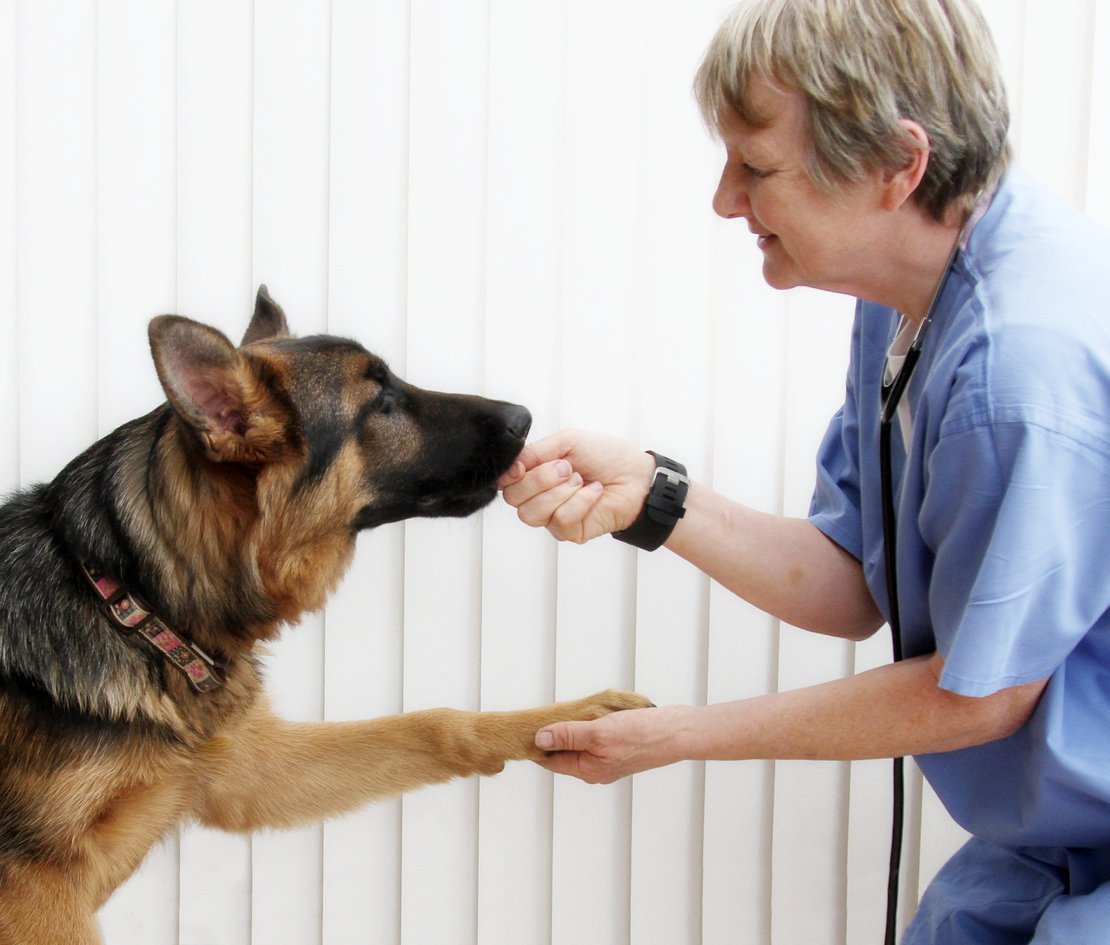
If your German Shepherd already has hip dysplasia, then preventative measures aren’t going to do him much good.
Let’s talk treatment instead.
1. Surgery
We’re going to get our least favourite treatment measure out of the way first. No pet parent wants to see their beloved pet go under the knife.
But if your German Shepherd’s hip dysplasia is severe, your vet may recommend surgery. The most serious surgeries require a total hip replacement.
Unfortunately, this is also a fairly expensive treatment option. Hip dysplasia surgery can range in price from $1,700 to more than $4,500.
Given the intrusive nature of the surgery, as well as its cost, your vet may suggest some of the other options listed below before recommending surgery.
Alright, we got the bad news out of the way. Let’s talk about some of those other treatment measures now, shall we?
2. Physical Rehabilitation
A less intrusive treatment option for German Shepherd hip dysplasia is physical rehabilitation.
If your vet recommends physical rehab, your dog will take part in a slow-and-steady exercise regimen that helps him build strength while managing the symptoms of hip dysplasia.
For example, your dog might walk on an underwater treadmill. This assists your dog by improving his strength without placing his full weight on his hips.
And there are other types of physical rehabilitation too. Check out the table below, which outlines some of these therapies and their benefits.
| Type of Physical Rehabilitation | Benefit |
| Stretching |
|
| Cold therapy |
|
| Hydrotherapy |
|
| Laser therapy |
|
3. Joint Supplements
We’ve got a lot to say about joint supplements, and we’re going to spend even more time talking about how they can benefit dog hip dysplasia soon.
But the key thing to know for now is that certain active ingredients in joint supplements help manage the symptoms of hip dysplasia:
- Glucosamine
- Chondroitin
- MSM
- Hyaluronic Acid
That’s because hip dysplasia can cause the secondary condition of arthritis, where the cartilage in your dog’s joints wears away. This causes bones to rub against each other which, as we’re sure you can imagine, is incredibly painful.
Joint supplements help maintain and improve the health of your dog’s cartilage, thereby helping treat the symptoms of German Shepherd hip dysplasia.
Check out the table below to learn what each of the active ingredients we listed above does to help your dog’s hip dysplasia.
| Active Ingredient | Benefit for Hip Dysplasia |
| Glucosamine | Repairs and builds cartilage |
| Chondroitin | Prevents cartilage deterioration |
| MSM | Reduces pain and inflammation |
| Hyaluronic Acid | Helps with joint lubrication |
4. NSAIDs (Nonsteroidal anti-inflammatory drugs)
Just like humans, dogs can benefit from taking certain pain medications to treat their hip dysplasia.
In particular, NSAIDs can benefit your dog by reducing some of the pain and inflammation that hip dysplasia causes.
If your dog has hip dysplasia, your vet may prescribe an NSAID that is safe for dogs. Some of these NSAIDs are listed below:
- Carprofen
- Deracoxib
- Meloxicam
And take note: you should never, ever give your German Shepherd an over-the-counter NSAID that was made for humans. What’s safe for a human can be toxic for your dog, so always rely on your vet to prescribe pain medication for your pup.
5. Weight Reduction
Nobody wants to hear that they need to lose weight, least of all your food-crazy pup.
But weight loss can be a helpful way to minimize some of the painful symptoms of hip dysplasia.
There are some great charts available online that show you how much your German Shepherd should weigh at various stages of his life.
Because your dog’s overall weight also depends on how big his overall frame is, you should work with your vet to determine a healthy weight loss strategy that aligns with your dog’s needs.
When you’re trying to help your dog lose weight, be careful about how much exercise your dog receives. You want to be sure he’s getting plenty of exercises while also not pushing him too hard and aggravating the symptoms of hip dysplasia.
Hard surfaces can be especially painful for your dog to walk on, so avoid walking on asphalt and sidewalks and instead take him for a walk in a grassy park.
Benefits of Dog Joint Supplements
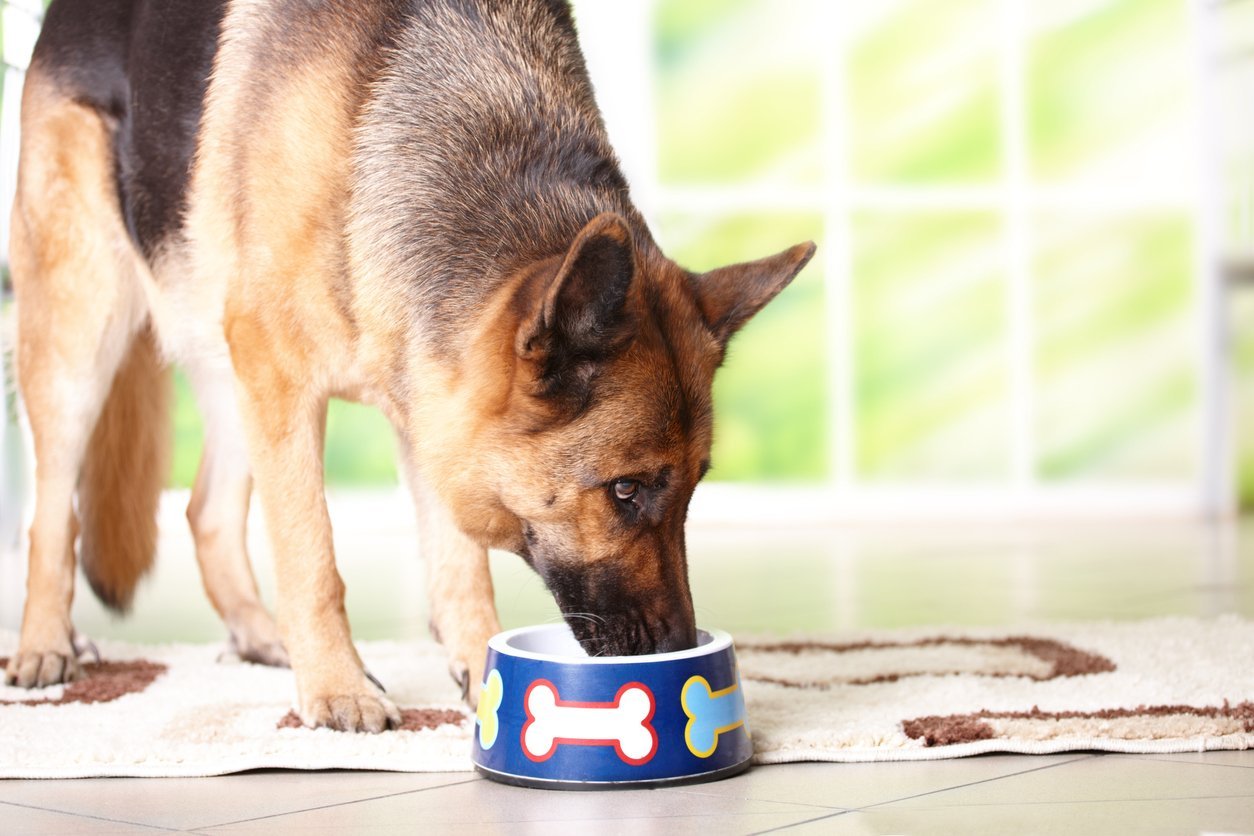
While you can’t entirely reduce the risk of your dog developing hip dysplasia, dog joint supplements are a great way to help maintain joint health and treat this condition.
1. Repair and Prevent Cartilage Deterioration
We mentioned cartilage a bit earlier.
And we’re talking about it again because cartilage is an incredibly important part of your dog’s hip joint. When your dog moves, cartilage helps cushion the joint.
But it can become damaged when your dog has hip dysplasia.
That’s because the femoral head (known as the “ball” in your dog’s ball and hip joint) doesn’t sit properly in the hip socket.
Over time, this cartilage deteriorates, causing pain and inflammation.
Another word for this cartilage deterioration? Arthritis.
Fortunately, certain active ingredients can help maintain joint health and reduce the likelihood that the secondary condition of arthritis will form as a result of German Shepherd hip dysplasia.
In particular, the active ingredients of chondroitin and glucosamine for dogs help maintain cartilage health.
These two naturally occurring substances work together to not only repair damaged cartilage but also prevent it from deteriorating in the first place.
2. Lubricate Joints
Hyaluronic acid is another key active ingredient that benefits dogs suffering from German Shepherd hip dysplasia by improving joint mobility and reducing discomfort.
In particular, hyaluronic acid may help reduce the pain your dog experiences as a result of hip dysplasia.
And how does it do that?
Well, hyaluronic acid is an important component of synovial fluid. Synovial fluid helps lubricate your dog’s joints and is found inside your dog’s joint capsules.
More specifically, hyaluronic acid improves the viscosity of this fluid, thereby helping your dog’s joints move more smoothly.
So it stands to reason that making sure your dog has enough hyaluronic acid is a great way to ensure his hip joints can move as smoothly as possible.
3. Reduce Pain and Inflammation
There’s a reason your dog is hesitant to play ball like he used to, after all. He’s in pain from common German Shepherd hip problems!
But fortunately, MSM, a powerful antioxidant and building block for healthy joints, can help reduce the pain and inflammation your dog experiences from hip dysplasia.
And the great news is that this ingredient is often found in joint supplements. Additionally, MSM may become even more effective when used alongside glucosamine, another common active ingredient.
To top it all off, MSM is great for your dog’s immune system, so he won’t have to deal with something as mundane as a cold on top of managing his hip dysplasia.
Best Supplements for Dogs with Hip Dysplasia
Now that you know how great joint supplements are for treating German Shepherd hip problems, let’s take a look at the three best supplements on the market for dogs with this condition.
1. Integricare TRI-ACTA H.A.

TRI-ACTA H.A. for Pets is the maximum strength version of TRI-ACTA for pets and the number one pet supplement option for dogs with hip dysplasia.
Yes, that is indeed our product.
But no, we aren’t just saying that because it’s ours.
It’s number one on our list because it contains all the active ingredients we mentioned before:
- Two types of glucosamine
- Chondroitin
- Hyaluronic acid
- MSM
And it only contains those ingredients. In other words: there are no fillers. So your dog is getting all the active ingredients he needs, and you’re not paying for unnecessary additives (meaning it also lasts a heck of a lot longer per container).
Plus, it comes in powdered form, so it’s incredibly easy to add small disguised amounts to your dog’s food.
Price $27.99 to $79.99 as of September 2021
2. Infinite Hip & Joint Supplement

The third joint supplement on our list, Infinite Hip & Joint Supplement, is an all-natural option that contains glucosamine, chondroitin, and MSM.
It also contains turmeric, which can help reduce inflammation in your dog’s body.
This supplement is manufactured in the USA and is very affordable… but comes with a catch.
There’s no hyaluronic acid and significantly fewer active ingredients than TRI-ACTA H.A. for pets.
As such, this may be a better option for pet parents who are simply looking to maintain overall joint health, rather than treat hip dysplasia.
Price $24.97 as of September 2021
Common Large Breed Hip Dysplasia Q&A
How long can dogs live with hip dysplasia?
One silver lining about hip dysplasia is that dogs with this condition can still live well into old age. The key to maintaining the health and well-being of your dog into his golden years is managing his condition, whether that’s feeding your dog a supplement or helping him lose some weight.
Managing his condition is especially important as your dog ages, as he will likely begin experiencing more pain and stiffness as he gets older.
Can dogs live with hip dysplasia without surgery?
Yes. Surgery isn’t necessary for all dogs who have hip dysplasia. Your vet will be able to determine whether surgery is the best treatment option for your dog’s specific circumstances.
How can I treat my dog’s hip dysplasia at home?
Always speak with your vet to determine the best treatment for your dog. In some cases, surgery may be necessary to remedy your dog’s hip dysplasia. In others, your vet may recommend at-home treatment measures, such as limiting intensive exercise or feeding your dog a high-quality joint supplement.
Final Thoughts on German Shepherd Hip Problems
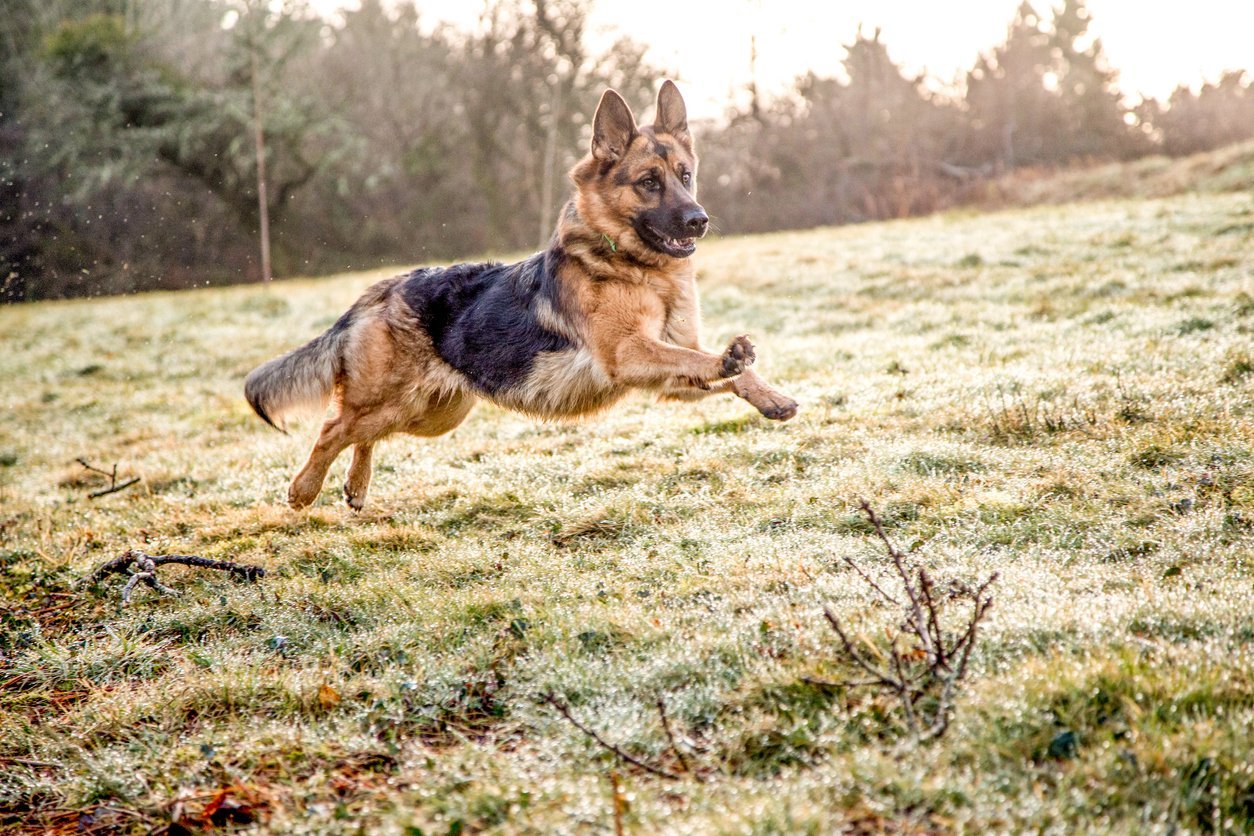
German Shepherd hip dysplasia isn’t something you want to ignore.
The longer you allow your dog to suffer from these symptoms without treatment, the worse the condition can get.
If you notice your dog has any of the German Shepherd Hip Dysplasia signs we discussed above, you should plan to call your vet so that you can get him on a treatment plan ASAP.
Part of a great treatment plan is feeding your dog a comprehensive joint supplement like TRI-ACTA H.A. for pets.
TRI-ACTA H.A. for Pets
Our maximum strength formula is optimally designed to accelerate the formation of cartilage, minimize inflammation, expedite the healing process, and improve joint conditions.

So what are you waiting for? Find out where to buy this supplement near you.
Newsletter Signup
Subscribe to our newsletter to receive the latest news and exclusive offers.
.jpg?height=2000&name=Cliick_Integricare-DISPLAY-REVISEDV2%20(1).jpg)
Proactive & Therapeutic Joint Supplements
When given daily, Integricare joint supplements recover bone and joint injuries faster and help prevent mobility injuries from happening in the first place.

